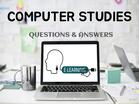The diagram below shows four common network topologies A, B, C(i) Name the network topologies labeled A, B, C and (4 marks)
(ii) Explain what happens if server X in topology A fails. (1 mark)
(iii) List two problems associated with network topology B. (2 marks)
(iv) List two disadvantages associated with network topology D. (2 marks)
0 Comments
What is multiplexing?
WHAT IS MODULATION?
List and explain the two data transmission techniquesPacket switching
Circuit switching
Below is a diagram of a network topology Name the above topology Tree topology State two advantages and two disadvantages of using the topology named above Advantages of Tree topology
Disadvantages Tree topology
Distinguish between the following terms as used in data communicationGuided transmission medium and unguided transmission mediaGuided transmission medium is a transmission medium that transmits data to its destination using a physical medium such as cables while unguided transmission media is one that transmits data though free space. There is no physical connection between the communicating devices. Multiplexing and demultiplexingMultiplexing Is the process of sending multiple data signals over a single medium along a communication channel. While demultiplexing is the process of separating the multiplexed signals at the receiving end of a channel back to the number of transmission channels multiplexed. Logical and physical TopologyThe physical topology of a network refers to the physical arrangement of cables, computers, and other peripheral devices on a network.
Logical topology is the method used to pass information between computers on a network. KASSU Secondary School intends to set up internet connection in their school for e-learning purposes. Advise the school management on four internet connectivity requirements that is required for them to be able to access internet.
Match the following statements with repeater, rooter or a bridge
Network Interface Card (NIC) A device that creates a physical link between a computer and the Network GatewayA computer or device that connects networks with different protocols or internet BridgeA device that divides a network into segments Repeatera device that receives a weak signal, cleans, amplifies it and the retransmit
Distinguish between logical and physical network topology
Advantages of satellite transmission
List two disadvantages of fiber optic cable
High Height Academy wanted to network computers in their school’s computer Laboratory so that they can share resources. The computer laboratory has 30 computers.
|
Categories
All
Archives
December 2024
|
Can't find what you are looking for? Don't worry, Use the Search Box Below.
|
Primary Resources
College Resources
|
Secondary Resources
|
Contact Us
Manyam Franchise
P.O Box 1189 - 40200 Kisii Tel: 0728 450 424 Tel: 0738 619 279 E-mail - sales@manyamfranchise.com |



 RSS Feed
RSS Feed

